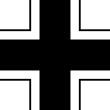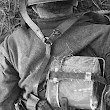After the Nazi rise to power in 1933, one of Adolf Hitler's most overt and audacious moves was to establish the Wehrmacht, a modern offensively-capable armed force, fulfilling the Nazi regime's long-term goals of regaining lost territory as well as gaining new territory and dominating its neighbors. This required the reinstatement of conscription, and massive investment and defense spending on the arms industry.
The Wehrmacht formed the heart of Germany's politico-military power. In the early part of the Second World War, the Wehrmacht employed combined arms tactics (close cover air-support, tanks, and infantry) to devastating effect in what became known as a Blitzkrieg (lightning war). Its campaigns in France (1940), the Soviet Union (1941), and North Africa (1941/42) are regarded as acts of boldness. At the same time, the far-flung advances strained the Wehrmacht's capacity to the breaking point, culminating in the first major defeat in the Battle of Moscow (1941); by late 1942, Germany was losing the initiative in all theatres. The operational art was no match to the war-making abilities of the Allied coalition, making the Wehrmacht's weaknesses in strategy, doctrine, and logistics readily apparent.
Closely cooperating with the SS and the Einsatzgruppen, the German armed forces committed numerous war crimes and atrocities, despite later denials and promotion of the myth of the Clean Wehrmacht. The majority of the war crimes were committed in the Soviet Union, Poland, Yugoslavia, Greece and Italy, as part of the war of annihilation against the Soviet Union, the Holocaust and Nazi security warfare.
During the war about 18 million men served in the Wehrmacht. By the time the war ended in Europe in May 1945, German forces (consisting of the Army, Navy and Luftwaffe, the Waffen-SS, the Volkssturm and foreign collaborateur units) had lost approximately 11,300,000 men, about half of whom were missing or killed during the war. Only a few of the Wehrmacht's upper leadership were tried for war crimes, despite evidence suggesting that more were involved in illegal actions. The majority of the three million Wehrmacht soldiers who invaded the USSR participated in committing war crimes.
German Army Expansion 1933-1939
https://www.youtube.com/watch?v=dlfcm7qTXEU
https://www.youtube.com/watch?v=kg8JM3SUeSU
Panzers in Poland 1939 – Success, Failures & Losses
https://www.youtube.com/watch?v=_1BmJ_GF97w
Tanks
https://www.youtube.com/playlist?list=PLtakTnKQQMCzmBWTzJTuGxckjx-oxH0JI
Tanks - Military History Visualized
https://www.youtube.com/playlist?list=PLv0uEimc-uN_TnM1wHY2xX6RwdVA23BHX
Weapons 101 - Military History Visualized
https://www.youtube.com/playlist?list=PLv0uEimc-uN-xmvYYHmcCSSZzPOEu0vEu
https://plus.google.com/103755316640704343614/posts/5iSxR5yBtzE
German Military History - Military History Visualized
https://www.youtube.com/playlist?list=PLv0uEimc-uN86P9RyMisSISjirwnJbQso
Military History Visualized >> playlists
https://www.youtube.com/channel/UCK09g6gYGMvU-0x1VCF1hgA/playlists
https://www.youtube.com/playlist?list=PLv0uEimc-uN-xmvYYHmcCSSZzPOEu0vEu
German Forces
https://www.youtube.com/playlist?list=PLtakTnKQQMCz5u3tt0EG-o-5x6BiDMDQB
How to Pronounce German WW2 Units from the Panzer Lehr in Steel Division '44
https://www.youtube.com/watch?v=FiQn4_PJfx4
German Forces - tb >> .
> Bundeswehr >>
German Ranks: Which rank commanded which Unit? > .
Kriegsmarine:
The Wehrmacht -- "Defence Force" -- was the unified armed forces of Nazi Germany from 1935 to 1946. It consisted of the Heer (army), the Kriegsmarine (navy) and the Luftwaffe (air force).
The designation Wehrmacht for Nazi Germany's military replaced the previously used term, Reichswehr (1919–35), and was the manifestation of Nazi Germany's efforts to rearm the nation to a greater extent than the Treaty of Versailles permitted.
https://en.wikipedia.org/wiki/Wehrmacht
Civilian deaths during the war include air raid deaths, estimates of German civilians killed only by Allied strategic bombing have ranged from around 350,000 to 500,000. Civilian deaths, due to the flight and expulsion of Germans and the forced labor of Germans in the Soviet Union are disputed and range from 500,000 to over 2.0 million.
According to the German government Suchdienste (Search Service) there were 300,000 German victims (including Jews) of Nazi racial, political and religious persecution. This statistic does not include 200,000 German persons with mental and/or physical disabilities who were murdered in the Nazi euthanasia program.




No comments:
Post a Comment
Note: Only a member of this blog may post a comment.